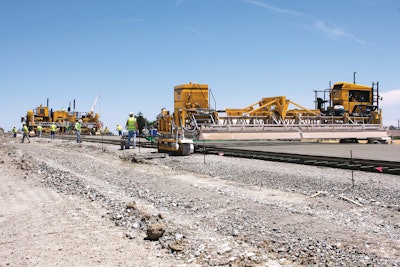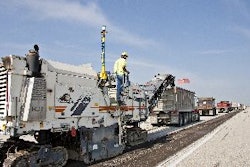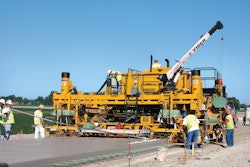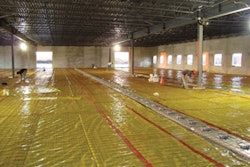
U.S. Route 24 was a two-lane highway through northwest Ohio. It’s a major shipping route, with trucks representing one third of the total volume of traffic. Safety of residential travelers was becoming a concern with such high truck volumes, so the Ohio Department of Transportation (ODOT) developed a plan to expand U.S. 24 into a four-lane divided highway. Work is currently underway on a 16-mile stretch between Napoleon and Toledo. Shelly & Sands Inc., based out of Zanesville, OH, is the contractor responsible for the concrete paving on the project.
A total of 245,000 cu. yds. of concrete will be slipformed on the highway expansion project. Shelly & Sands is using a variety of GOMACO equipment, including a PS-30 placer/spreader, a four-track GHP-2800 paver with IDBI and a T/C-600 texture/cure machine for the mainline paving. A four-track Commander III with an IDBI attachment is slipforming the project’s eight entrance/exit ramps.
“Basically, we have 16 miles of new four-lane divided highway,” says Paul Singleton, project superintendent for Shelly & Sands. “We’re slipping the roadway 24 ft. wide with the GHP-2800 with IDBI and we’re placing a 12-ft. and a 4-ft. shoulder with our other GOMACOs. We started the project last September and should be finished by the first of next year.”
Staying Ahead of Spec Requirements
Although Shelly & Sands’ contract doesn’t require completion until the end of 2012, mainline paving will be finished this season - a full year early - while quality has been maintained throughout the project.
ODOT has rigid specifications for both bar placement accuracy with the IDBIs and also project smoothness. It uses the International Roughness Index (IRI) to measure pavement smoothness, requiring numbers between 60 to 70 for 100% pay. Anything under a 60 earns incentive.
“This has been our first major project utilizing the IRI and it’s created some challenges and also had us reevaluate some of our methods,” notes Brian Little, concrete superintendent for Shelly & Sands.
Two of the changes implemented were the use of a placer/spreader in front of the paver and modification of the Auto-Float on the back of the paver. "We used to dump two trucks at a time in front of the paver, and we would go from a big head of concrete to sometimes hardly any at all," Little explains. "We also don’t start and stop the paver as much with the placer/spreader out front. It all helps achieve smoothness when you’re paving under the IRI specification.
“We’re doing pretty well with it. We’ve been averaging numbers in the upper 50s and low 60s," he adds. "We’ve even had numbers in some good-sized sections in the high 40s and mid-50s. We’re pretty happy with that.”
The concrete for the project is produced on-site by Shelly & Sands’ mobile batch plant. It produces two different mixes, depending on the temperature. Normal temperatures require an ODOT Class C mix with 550 lbs. of cement with a water reducer. When temperatures warm up, the mix is changed to 385lbs. of cement with 165 lbs. of slag. Concrete slump averages 1 to 1.5 in. The plant’s production averages 350 cu. yds. per hour with 25 trucks carrying 11-cu.-yd. loads of concrete to the paving train.
Shelly & Sands’ 2002 four-track GHP-2800 with IDBI is paving 24 ft. wide and 11.5 in. thick. The IDBI is inserting 24 bars, on-the-go, every 15 ft. to form the new highway’s transverse joints. The 1.5-in.-diameter bars are 18 in. long and placed on 12-in. centers across the width of the slab.
“ODOT is on site every day checking and verifying the placement and accuracy of our bars,” Little says. “Everything has been right where it should be, and we haven’t had any problems at all with the placement of the dowel bars.”
Shelly & Sands’ new T/C-600 texture/cure machine follows the paver applying a longitudinal tine and white spray cure to the new concrete. Paving production on the project averages 2,800 cu. yds. during a 12-hour shift.
Ramping Up Production
The eight entrance/exit ramps on the project are being slipformed 16 ft. wide and 11.5 in. thick using a 2010 four-track Commander III with an independent IDBI attachment. Before the new IDBI attachment, dowel baskets had to be placed on grade by hand during paving. The process required more laborers, materials and time to finish a single ramp.
“We do a lot of ramp work,” Little points out. “Very rarely is there any room for a haul road, so we were always putting baskets down by hand as we paved. This IDBI attachment just makes everything better.
“You don’t have to worry about getting your baskets placed right and the IDBI attachment is a lot quicker," he states. "It takes less people, material costs go way down with a straight dowel bar vs. a basket and we achieve higher production.”
The IDBI attachment is placing 16 bars on 12-in. centers across the width of the ramp. Transverse joints are placed at 15-ft. intervals.
“It’s working great,” says Johnny VanDyne, paving crew foreman. “The switch to the IDBI’s new G+ controls has been pretty much flawless and the operator did great with it. Production has been fantastic, too. On a typical 700-cu.-yd. ramp, it would have taken us 12 to 14 hours for setting dowel baskets, tie bars and paving. With this new machine, we have about five hours in total slipping it.
“Accuracy of the bar placement has been wonderful, too," he says. "We show the inspectors right off the bat how we string it and get our depth and then we’ll dig up some of the placed bars here and there for them to visually check them. All of the testing has been great.”
The Commander III is also equipped with a front-mounted and two hydraulic, side-mounted bar inserters. A number five bar, 18 in. long, is inserted every 26 in. by the front-mounted bar inserter for the longitudinal joint. Tie bars are inserted into both sides of the new ramp on 18-in. centers with the hydraulic side bar inserters.
“Before the Commander III with IDBI attachment, each one of these ramps would have been an all day project for us. Now, with the new GOMACO machines, we can slip each one in approximately five hours, using two to three less laborers on the crew,” Little says. “It works out great and you can use it everywhere.”
Shelly & Sands has 70,000 cu. yds. of four-lane divided highway in Athens, OH, to finish up. After that, it’s on to Columbus, to start a 280,000-cu.-yd. rehabilitation project on Interstate 270.


















